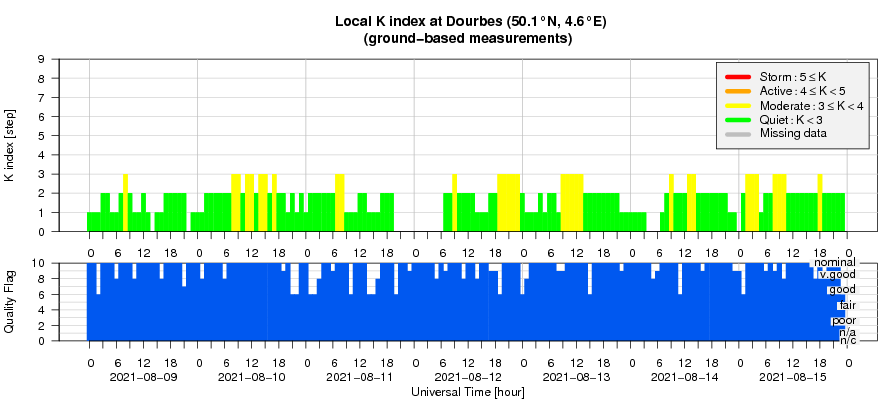- Table of Content
- 1.The Sun at a g...
- 2.ISSI Game Chan...
- 3.Sunspot drawin...
- 4.Review of sola...
- 5.PROBA2 Observa...
- 6.The Internatio...
- 7.Review of geom...
- 8.Geomagnetic Ob...
- 9.The SIDC Space...
- 10.Review of iono...
- 11.STCE in action...
2. ISSI Game Changers Online Seminars
3. Sunspot drawings movie
4. Review of solar activity
5. PROBA2 Observations (9 Aug 2021 - 15 Aug 2021)
6. The International Sunspot Number by Silso
7. Review of geomagnetic activity
8. Geomagnetic Observations at Dourbes (9 Aug 2021 - 15 Aug 2021)
9. The SIDC Space Weather Briefing
10. Review of ionospheric activity (9 Aug 2021 - 15 Aug 2021)
11. STCE in action: upcoming events
The Sun at a glance - infographics contest for schools
The European Solar Telescope (EST) project is organising an international contest for secondary schools called "The Sun at a glance". Students from all over Europe are invited to research different subjects related to our star and help build the EST Solarpedia, an open educational resource about the Sun.
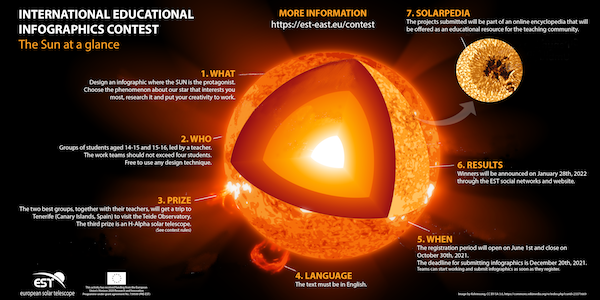
The European Association for Solar Telescopes (EAST) brings together a group of research institutions from 18 European countries, including the STCE represented by the Royal observatory of Belgium (ROB), that have extensive experience in the study of our Sun. The goal of EAST is to ensure that European solar astronomers have access to world-class high-resolution ground-based observing facilities and therefore promotes the development, construction and operation of a state-of-the-art European Solar Telescope in the Canaries.
Participants will have to design an infographic where the Sun is the protagonist. An infographic is a collection of images, charts, and minimal text that gives an easy-to-understand overview of a topic, in this case related to the Sun or solar telescopes. The two best designs will win a trip to Tenerife (Canary Islands, Spain) to visit Teide Observatory and the European solar telescopes in operation there! The third prize will be an H-alpha solar telescope.
The contest is open to schools in all European Union countries plus Andorra, Iceland, Liechtenstein, Norway, Switzerland and the UK. It is addressed to groups of 4 students in the school years corresponding to the age range 14-16y, under the guidance of a teacher. The teacher is encouraged to involve other STEM teachers as this is a unique opportunity to combine work in physics, maths, chemistry, biology, art, IT, English and even history!
The teacher leading the student team must register before October 30, 2021 to participate in the contest. There is no fee to enter the contest. Teams can submit their infographics anytime after registration, with a deadline on December 20, 2021. The contest winners will be announced by January 28, 2022 through the EST website and EST social media.
For more information and registration, please visit https://est-east.eu/contest.

ISSI Game Changers Online Seminars
At the International Space Science Institute (ISSI) in Bern (Switzerland) scientists from all over the world meet in a multi- and interdisciplinary setting to reach out for new scientific horizons. Its main function is to contribute to the achievement of a deeper understanding of the results from different space missions, ground based observations and laboratory experiments, and adding value to those results through multidisciplinary research in the framework of International Teams, Workshops, Working Groups, Forums or as individual Visiting Scientists. The program of ISSI covers a wide spectrum of disciplines including the physics of the solar system and planetary sciences to astrophysics and cosmology, and from Earth sciences to astrobiology.
ISSI started its first online Seminar series last summer 2020. While ISSI's mission is to provide the international Space Science Community with a forum for meeting and discussion in an informal and productive atmosphere, the COVID-19 crisis has accelerated earlier plans for online tools to supplement the core in-person meeting program.
The Game Changers Online Seminars discuss ideas and findings about the solar system, the universe and our terrestrial environment.
Video's of the 2020-2021 seminar season are collected here: https://www.issibern.ch/issi-spotlight/recorded-game-changers-seminars/
A new series of seminars will start on September 16th and will be announced in this newsletter. More details on: https://www.issibern.ch/issi-spotlight/online-seminars-game-changers/
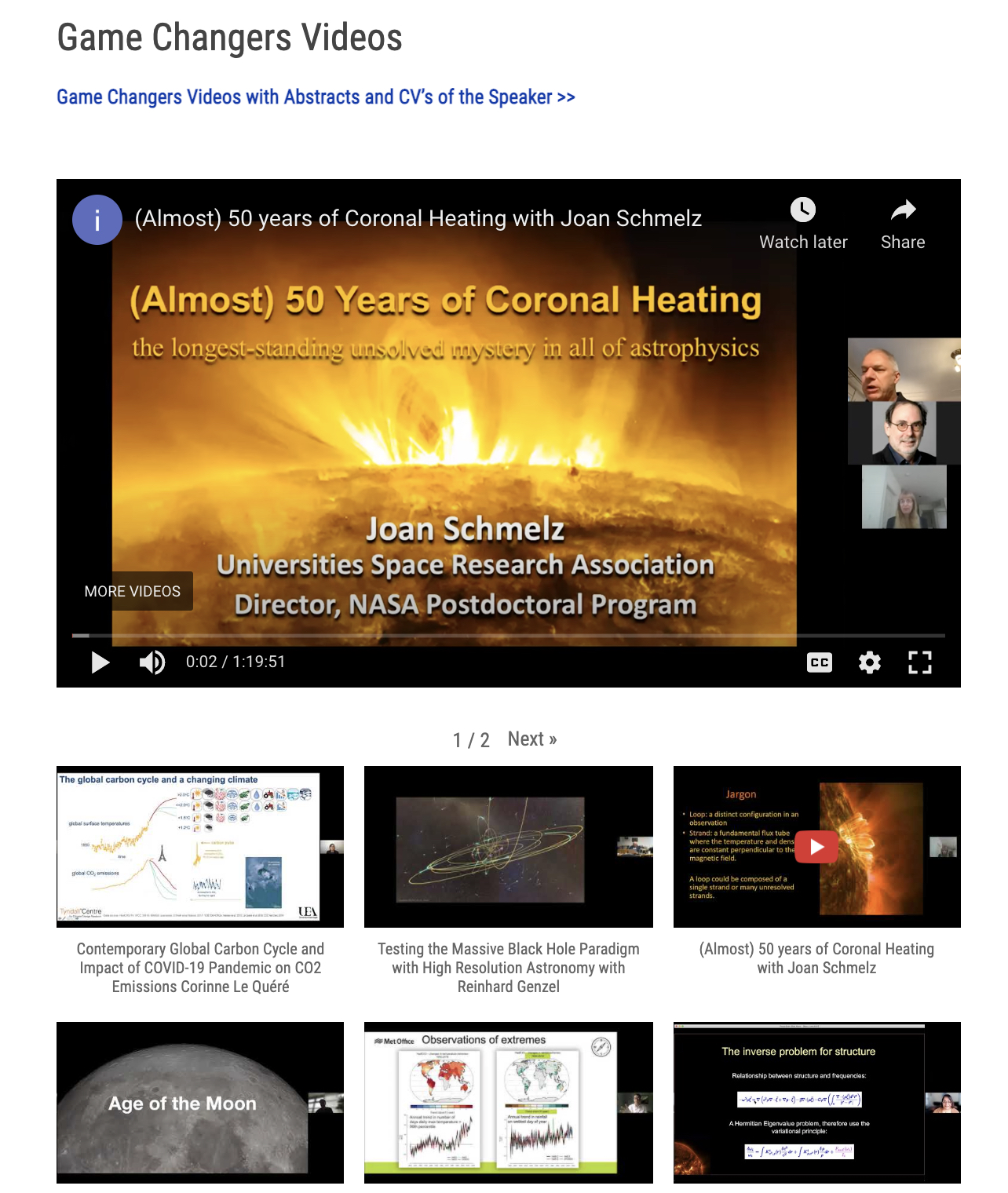
Sunspot drawings movie
Here is an animated gif of the sunspot drawings made from Aug 9 to 15. One of the STCE observers climbs every day the solar dome to draw sunspots, if any and if weather and clouds permit. When there are no sunspots visible on the solar projection, the observer has nothing to draw and the USET Wolf number is simply zero. The Wolf number equals 10*G + S with S, the number of sunspots and G, the number of sunspot groups.
We made this animated gif because there is so much beauty in this simple way of observing. The observer on duty was 'JV'. Many observers spread over the world do the same and send us their numbers. We put them together to calculate the International Sunspot Number which is a high quality index for solar activity. We make sure that this long term observation is kept and made available for all interested.
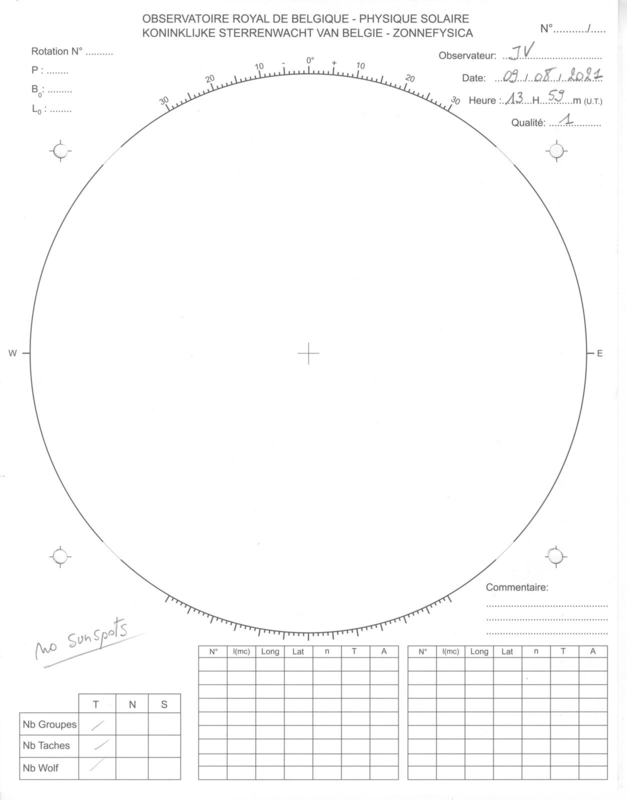
Enjoy
The daily drawings and pictures are available on http://www.sidc.be/uset/
Review of solar activity
Five numbered active regions were observed on the side of the solar disc visible from Earth: NOAA AR 2852,2853,2854,2855,2856. GOES reported 2 C-class flare and numerous A and B-class flares. The largest reported flare was a C1.4 class flare and took place on Aug 13 20:59UT, originating from the plage region of what was Catania region 29.
No Earth directed Coronal Mass Ejections (CME's) have been observed in coronagraph data.
The greater than 10 MeV proton flux was at background levels, the greater than 2MeV electron flux was bellow the 1000 pfu threshold and the 24h electron fluence was at normal levels as well.
PROBA2 Observations (9 Aug 2021 - 15 Aug 2021)
Solar Activity
Solar flare activity fluctuated between very low and low during the week.
In order to view the activity of this week in more detail, we suggest to go to the following website from which all the daily (normal and difference) movies can be accessed: https://proba2.oma.be/ssa
This page also lists the recorded flaring events.
A weekly overview movie can be found here (SWAP week 594): https://proba2.sidc.be/swap/data/mpg/movies/weekly_movies/weekly_movie_2021_08_09.mp4
Details about some of this week's events can be found further below.
If any of the linked movies are unavailable they can be found in the P2SC movie repository here: https://proba2.oma.be/swap/data/mpg/movies/
Friday Aug 13
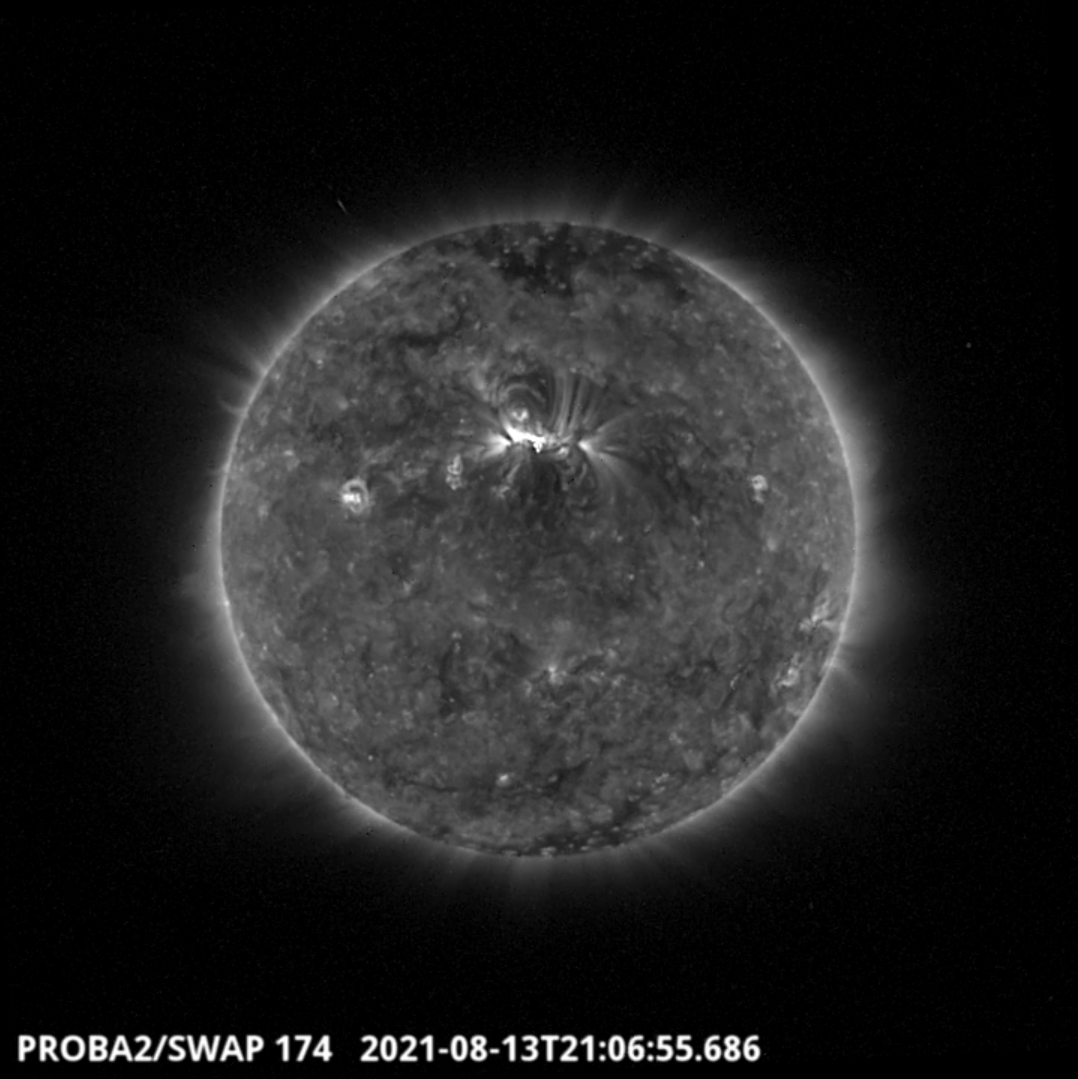
The largest flare of the week, a C1.4 flare, was observed by SWAP and LYRA. The flare and associated eruption is visible near the centre of the solar disk on 2021-Aug-13, as shown in the SWAP image above taken at 21:06 UT.
Find a movie of the event here (SWAP movie): https://proba2.sidc.be/swap/movies/20210813_swap_movie.mp4
The International Sunspot Number by Silso
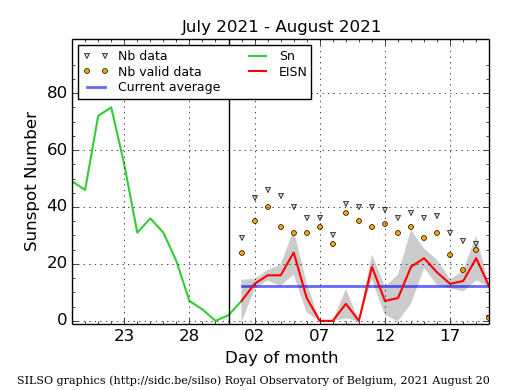
The daily Estimated International Sunspot Number (EISN, red curve with shaded error) derived by a simplified method from real-time data from the worldwide SILSO network. It extends the official Sunspot Number from the full processing of the preceding month (green line), a few days more than one solar rotation. The horizontal blue line shows the current monthly average. The yellow dots gives the number of stations that provided valid data. Valid data are used to calculate the EISN. The triangle gives the number of stations providing data. When a triangle and a yellow dot coincide, it means that all the data is used to calculate the EISN of that day.
Review of geomagnetic activity
The solar wind parameters (as observed by ACE and DSCOVR) became enhanced due to the high-speed streams associated with the negative polarity southern polar coronal hole (Aug 10-11) and the positive polarity northern polar coronal hole (Aug 15-16). The solar wind speed increased to values above 500 km/s on Aug 15. The interplanetary magnetic field magnitude reached values up to 9 nT on Aug 15, and the Bz component fluctuated dropping to -8 nT on the same day.
The geomagnetic conditions were varying from quiet to unsettled over the past week in responses to the aforementioned high-speed streams (NOAA-Kp and K-Dourbes equal 3).
The SIDC Space Weather Briefing
The Space Weather Briefing presented by the forecaster on duty from Aug 8 to 15. It reflects in images and graphs what is written in the Solar and Geomagnetic Activity report.

A pdf-version: https://www.stce.be/briefings/20210816_SWbriefing.pdf
The movie: https://www.stce.be/briefings/20210816_SWbriefing.m4v
Review of ionospheric activity (9 Aug 2021 - 15 Aug 2021)
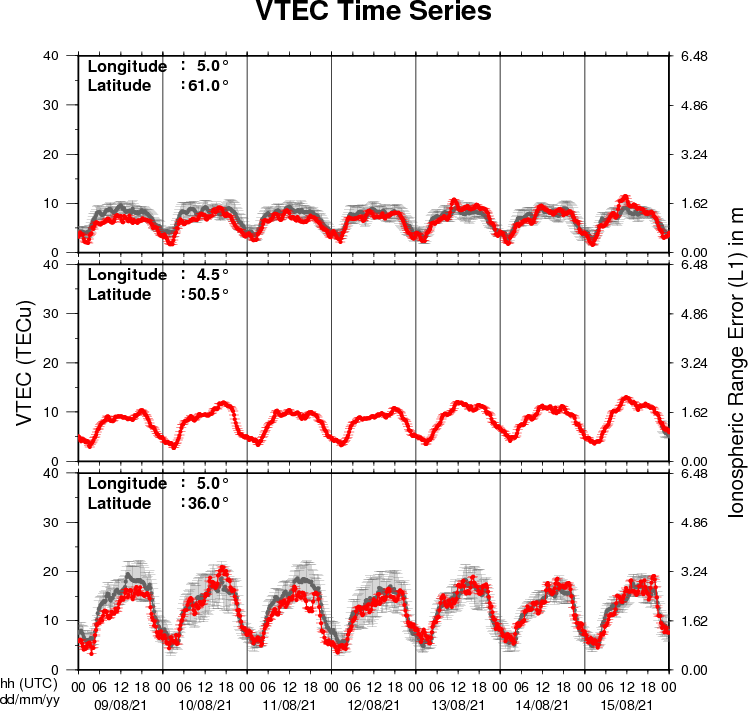
The figure shows the time evolution of the Vertical Total Electron Content (VTEC) (in red) during the last week at three locations:
a) in the northern part of Europe(N61°, 5°E)
b) above Brussels(N50.5°, 4.5°E)
c) in the southern part of Europe(N36°, 5°E)
This figure also shows (in grey) the normal ionospheric behaviour expected based on the median VTEC from the 15 previous days.
The VTEC is expressed in TECu (with TECu=10^16 electrons per square meter) and is directly related to the signal propagation delay due to the ionosphere (in figure: delay on GPS L1 frequency).
The Sun's radiation ionizes the Earth's upper atmosphere, the ionosphere, located from about 60km to 1000km above the Earth's surface.The ionization process in the ionosphere produces ions and free electrons. These electrons perturb the propagation of the GNSS (Global Navigation Satellite System) signals by inducing a so-called ionospheric delay.
See http://stce.be/newsletter/GNSS_final.pdf for some more explanations ; for detailed information, see http://gnss.be/ionosphere_tutorial.php
STCE in action: upcoming events
Check out our activity calendar: activities and encounters with space weather as main theme. These are occasions to get submerged in the world of space weather through scientific, educational, informative and instructive activities.
Aug 23, 13:00 - Lecture, The Sun. The STCE is guest speaker on a summer school organised by VVS in Leuven, Belgium.
Sept 24 and Sept 25 - Wise Night, European Researchers' Night. The STCE organises 'The Northern lights: a tale or science?' and 'Alert in the space weather room', Planetarium Heizel, Brussels, Belgium.
Oct 11, 12, 14 and 15 - SWx Introductory Course. Online course organised by the Space Weather Education Center of the STCE. Full.
Nov 22, 23, 25 and 26 - SWx Introductory Course. Online course organised by the Space Weather Education Center of the STCE. 3 seats still available.

More: STCE website (https://www.stce.be), link UPCOMING or STCE IN ACTION
